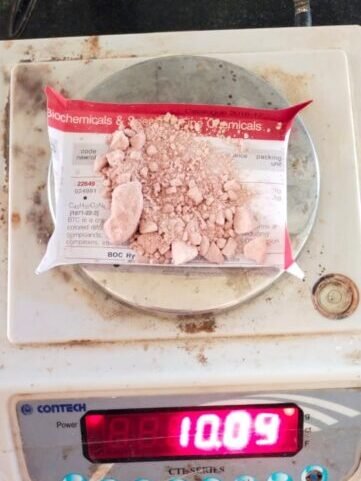19 January 2025
Introduction :- Calcium Oxalate is waste product from the ASK chemicals. In that waste product oxalic acid content is more so, we decided to recover oxalic acid from that product. After recovery we will get either crude or pure oxalic acid. This will further used as cleansing agent to remove the mineral deposits in pipes which is also called as pipe drifting. The pure oxalic acid will give back to the ASK chemicals as it is used as catalyst in various chemical reactions. The waste product they provided is calcium Oxalate with other impurities so, we cannot just assume that it only Calcium Oxalate.
20 January 2025
first we searched for the characteristics of each compound that has been used for the experiment
- Calcium Oxalate (CaC2O4)- white or colorless crystalline solids solubility – highly insoluble in water ( 1.41× 10-5) Molar Mass – 128.096g/mol, Melting Point – 200o C
- Sulphuric Acid( H2SO4) – Thick, Colorless, oily liquid, Density – 1.84g/cm3 , Boiling Point- 337o C , Molecular Weight – 98.08g/mol
- Hydrochloric acid (HCl) – Molar Mass – 36.46g/mol , Appearance – colorless slightly yellow, Boiling Point-123 F
- Calcium Sulphate ( CaSO4) – Appearance – white colorless, crystalline reddish, brick tinge, Molecular Weight – 136.14g/mol, Melting Point- 1460oC Solubility – slightly soluble in water
- Oxalic Acid – colorless odorless, Crystalline solids, Physical Appearance – white, crystalline solids ,Molecular Weight – 90.03g/mol, Melting Point-189.5oC, solubility – soluble in water 46.9 (5 °C)57.2 (10 °C)75.5 (15 °C)95.5 (20 °C)118 (25 °C)139 (30 °C)178 (35 °C)217 (40 °C)261 (45 °C)315 (50 °C)376 (55 °C)426 (60 °C)548 (65 °C). This is going to be a very important property of oxalic acid for further purification process.
- For the recovery we have used two acids sulphuric Acid and hydrochloric acid which will a altimately forms oxalic acid so our tasks begins from here.
During this project we have also discussed about simple basic concepts including the monobasic acid, dibasic acid and the common ion effects they have played a key role in our experiment.
Material:-
- Sulphuric Acid ( H2SO4) 98%
- Hydrochloric Acid (HCl) 36.46%
- Distilled Water
- conical flask
- Beaker
- Funnel
- Whatman filter paper 41
- Glass Rod etc.
Procedure :-gh
23 January 2025
A. Reaction with Sulphuric Acid H2SO4
- Taken 10g of Calcium Oxalate in 100ml distilled water.
- 8.5g sulphuric Acid has added to the above solution which has been taken with respect to their mole ratio . To determine the amount of sulphuric Acid H2SO4 needed to react with 10g Calcium Oxalate( CaC2O4), we need to consider stoichiometry of the reaction between calcium Oxalate and sulphuric Acid The balanced chemical equation for the reaction is
CaC2O4 + H2SO4 ➡️ CaSO4 + H2C2O4
from the equation we can see that 1 mole of calcium Oxalate reacts with 1 mole of sulphuric Acid. The molar mass of calcium Oxalate is 128.1g/mol. Convert mass of calcium Oxalate (10g) to moles= 0.078 moles of CaC2O4 .
Since the molar ratio between CaC2O4 and H2SO4 is 1:1, we need an equal no. Of H2SO4 for the reaction
0.078moles of CaC2O4 = 0.078 moles of H2SO4
convert moles of H2SO4 to grams using molar mass of H2SO4
0.078 moles × 98.08 g/moles= 7.65 grams of H2SO4
Usually we add more than calculated amount of compound so we added 8.5g of H2SO4.
4. We continued with two more cycles of the same procedure of above without the addition of distilled water in it
B. Reaction with Hydrochloric acid HCl
- Taken 10g of calcium oxalate in 100ml of distilled water.
- 17.04g of Hydrochloric Acid has added to the above solution with respect to their mole ratio. to determine the amount of hydrochloric acid needed to react with 10g calcium oxalate, we need to consider stoichiometry of reaction between calcium oxalate and hydrochloric acid
The balanced chemical equation for the reaction is,
CaC2O4 + 2HCl ➡️ CaCl2 + H2C2O4
from the equation we can see that 1 mole of Calcium Oxalate reacts with 2 moles of Hydrochloric Acid. The molar mass of Calcium Oxalate is approximately 128.1g/mol. First we need to convert the mass of Calcium Oxalate (10g) to moles
10/ 128.1g/mol = 0.078moles of CaC2O4, Since the molar ratio between CaC2O4 and HCl is 1:2, we need twice as many moles of HCl for the reaction
0.078 moles of CaC2O4 X 2 = 0.156 moles of HCl
convert moles of HCl to grams using molar mass of HCl 0.156 X 36.46g/mol = 5.68 grams of HCl X3 = 17.04 grams
as the purity of HCl is 36.46% so we need the calculation for 100% HCl so that why we multiplied here with 3, This will achieve the 100% purity.
3. For the removal of unreacted HCl we go for the distillation of this sample.
Observations and Result :-
24 to 28 January 2024
I have conducted approximately 10 to 15 trials, following the same procedure as described up to cycle one. After the first trial, the resulting supernatant contained sulfuric acid and oxalic acid, both of which exhibit high water solubility. Our focus was on removing the sulfate ions from the sulfuric acid. To achieve this, we reacted the supernatant with Barium Chloride (BaCl2). However, we did not know the exact number of sulfate ions or the concentration of sulfuric acid present in the supernatant.
A. Reaction with Sulphuric Acid H2SO4
CaC2O4 + H2SO4 ➡️ CaSO4 + H2C2O4
From the above reaction we get to know the when Calcium Oxalate (CaC2O4) reacts with Sulphuric Acid (H2SO4) will get calcium Sulphate which is precipitate and Oxalic Acid. But in our case we does not have the pure Calcium Oxalate with addition of that we also dont know the amount of Calcium Oxalate in it. So here we got the filtrate and the residue of Calcium Sulphate . In filtrate we have the oxalic acid, unreacted sulphuric acid and some minor amount of calcium Sulphate.
after discussion with Dixit Sir we concluded to reaction should go till 3 rd cycle, what will be possible results will work on that.
21 March 2025





Data obtained during three cycles
- 10g CaC2O4 sample + 100g H2O + 8.5g H2SO4 → First Cycle → Filter → Filtrate = 84ml , Residue = 9.97g
- ↓
- Filtrate (84ml) + 10g CaC2O4 sample + 8.5g H2SO4 → Second Cycle → Filter → Filtrate = 76ml, Residue = 10g
- ↓
- Filtrate (76ml) + 10g CaC2O4 sample + 8.5g H2SO4 → Third Cycle → Filter → Filtrate = 50 ml Residue = 10 g

22 March 2025
Formation of crystals refers to an interesting property called common ion effect
The common-ion effect is a term used to refer to the decrease in the solubility of a salt that occurs when the salt is dissolved in a solution that contains another source of one of its ions. The presence of Common-ion generally affects the solubility of salts and other weak electrolytes because it basically decreases the solubility of a solute as the ionization of a weak acid or weak base is decreased by any strong electrolyte that provides a common ion.
sulphuric acid and oxalic acid both are dibasic acid or diprotic acid (There are two ionisable hydrogen atoms present in each molecule of dibasic acids)
Here, sulphuric Acid H2SO4 is strong acid which dissociates completely in following way
H2SO4(aq) ⟶ H+(aq) +HSO4–(aq).
HSO4– ⇌ H+ + SO4–
Oxalic acid is weak Acid dissociates partially in following way , Oxalic acid is a diprotic acid it can donate two protons. In oxalic acid dissociation of the second proton is very low because after donating its first proton it acquires a negative charge and dissociation of the second proton becomes very difficult.
H2C2O4 ⇌H+ + HC2O4–
HC2O4-⇌H+ + C2O42-

27 March 2025
Then we go for the recrystallization
Recrystallization is a technique used to purify solid compounds. Solids tend to be more soluble in hot liquids than in cold liquids. During recrystallization, an impure solid compound is dissolved in a hot liquid until the solution is saturated, and then the liquid is allowed to cool. The compound should then form relatively pure crystals. Ideally, any impurities that are present remain in the solution and will not be incorporated into the growing crystals. The crystals can then be removed from the solution by filtration. Not all of the compound is recoverable — some will remain in the solution and will be lost. The solubility of a compound tends to increase with temperature, and is highly dependent on the choice of solvent. The greater the difference in solubility at high and low temperature, the more likely it is for the solute to come out of the solution as it cools, and form crystals.
The solvent chosen should have a boiling point of at least 40 °C so there is a significant temperature difference between boiling and room temperature. The solvent’s boiling point must also be below the melting point of the solute to enable crystallization. Rapid cooling of the solution induces the formation of many nucleation sites, thus favors the growth of many small crystals. However, slow cooling induces the formation of fewer nucleation sites, and favors larger and purer crystals. Thus, slow cooling is preferred.
Our compound is oxalic acid which have
- moderate solubility in water and solubility increases with increase in temperature 46.9 (5 °C)57.2 (10 °C)75.5 (15 °C)95.5 (20 °C)118 (25 °C)139 (30 °C)178 (35 °C)217 (40 °C)261 (45 °C)315 (50 °C)376 (55 °C)426 (60 °C)548 (65 °C).
- Solubility in other solvents like ethanol and slightly soluble in diethyl ether.
So, we selected water as a solvent for recrystallization. we does not go for ethanol although it has great solubility.
Reasons – a. we go for cost-effective solvents b. we avoid flammable liquid during recrystallization we need hot solvent.
Procedure –
- Taken crystals obtained after filtration of third cycle filtrate, which is about 10g crude oxalic acid.
- First dissolved the 10g of crude oxalic acid with only in hot water boiled at100°C but it does not completely dissolved. we cannot get pure oxalic acid at last
- We decided to change the solvent from water to 5% H2SO4 and boiled until it catch to100°C then added to sample it get dissolved completely.
- After that filtered that solution when it hot. Here our compound is in filtrate not on filter paper.
- when the filtrate cooled down we could clearly get to saw the crystals at bottom, again filtered we got our compound on filter paper as pure Oxalic Acid (C2H2O4)

10 April 2025
To check the purity of a compound, we often use its melting point. This method is relatively simple and doesn’t always require sophisticated instrument. To determine the melting point of oxalic acid, you can follow a standard laboratory procedure using a melting point apparatus or a capillary tube method. Here’s a step-by-step guide:
Materials –
- Capillary Tube (one side sealed)
- Paraffine liquid light
- Thiol tube
- stand
- Thermometer
- Thread
Procedure –
- Prepare the Sample:
- Fill a small amount of the powder into the capillary tube.
- Set Up the Apparatus:
- Insert the capillary tube along with thermometer, tie thermometer and Capillary tube with thread.
- Heat the Sample:
- Start heating slowly, especially as you approach the expected melting point (~190°C for oxalic acid dihydrate).
- Observe the temperature range over which the sample starts to melt and when it completely liquefies.
- Record the Melting Point:
- The melting point range is from the first sign of melting to complete liquefaction
Reference Melting Points
- Oxalic acid dihydrate (C₂H₂O₄·2H₂O): ~101–102°C (melts with decomposition due to water loss)
- Anhydrous oxalic acid: ~189–191°C
Results – The product we got after recrystallization showed melting point 102°C

Feb 22 2025
Reaction with Hydrochloric Acid (HCl)
CaC2O4 + 2HCl ➡️ CaCl2 + H2C2O4
In above reaction when Calcium Oxalate reacts with Hydrochloric Acid HCl it gives Calcium Chloride and Oxalic Acid, both of them are in dissolved form. It is very difficult to remove oxalic acid from calcium chloride and HCl.
The mother liquor contains Oxalic Acid, Calcium Chloride and HCl. To remove Chloride ions from the mother liquor we go for distillation where we put Silver Nitrate (AgNO3) the drop from condenser tube was treated with Silver Nitrate (AgNO3), if the chloride ions were there in that drop the white precipitation will form, with this principle we carried out this reaction.
Only 10 ml with no white ppt we get from above method.

10 ml distilled filtrate free from HCl then dried in oven
Dried Sample = 1.68 g from 10 g of.oxalic acid
This compound was with Calcium Chloride.
We are searching for the way to remove CaCl2 from above dried sample.
25 Feb 2025





